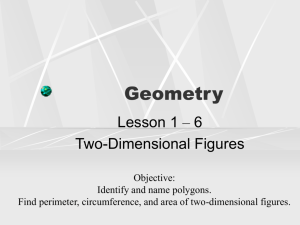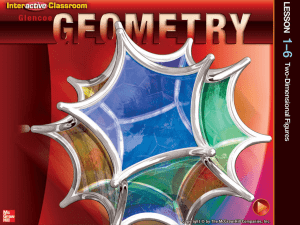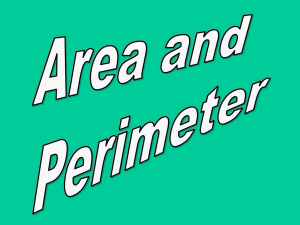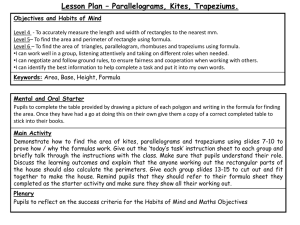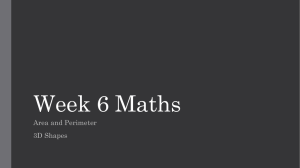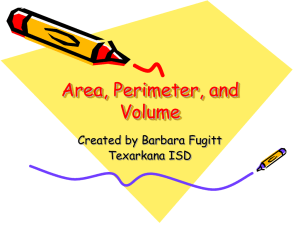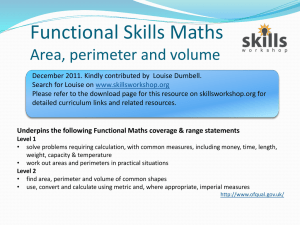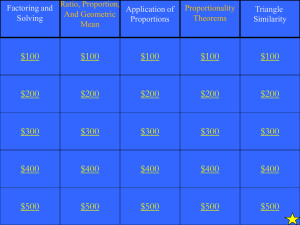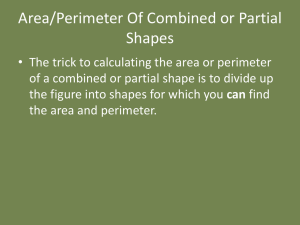Answer
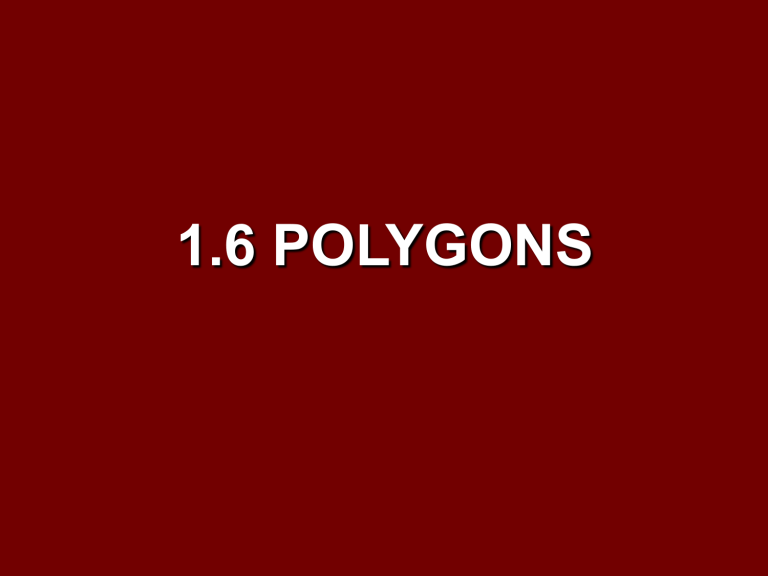
1.6 POLYGONS
Objectives
Identify and name polygons.
Find perimeters of polygons.
Polygons
Polygon
– a closed figure whose sides are formed by a finite number of coplanar segments
A
We name a polygon by using the letters of its vertices, written in consecutive order.
P Y T
C
X U
B D
Q R W V
Types of Polygons
If the lines of any segment of the polygon are drawn and any of the lines contain points that lie in the interior of the polygon, then it is
concave
.
Otherwise, it is
convex
lines are in the interior).
(no points of the
Classifying Polygons
Polygons are classified by the number of sides they have. A polygon with n number of sides is an n-gon .
Polygon Number of Sides
Triangle 3
Quadrilateral 4
Pentagon 5
Hexagon
Heptagon
Octagon
Nonagon
Decagon
8
9
6
7
10
Regular Polygons
A convex polygon in which all of the sides and all of the angles are congruent is called a regular polygon .
Example 1a:
Name the polygon by its number of sides. Then classify it as convex or concave, regular or irregular.
There are 4 sides, so this is a quadrilateral.
No line containing any of the sides will pass through the interior of the quadrilateral, so it is convex.
The sides are not congruent, so it is irregular.
Answer: quadrilateral, convex, irregular
Example 1b:
Name the polygon by its number of sides. Then classify it as convex or concave, regular or irregular.
There are 9 sides, so this is a nonagon.
A line containing some of the sides will pass through the interior of the nonagon, so it is concave.
The sides are not congruent, so it is irregular.
Answer: nonagon, concave, irregular
Your Turn:
Name each polygon by the number of sides. Then classify it as convex or concave, regular or irregular.
a.
Answer: triangle, convex, regular b.
Answer: quadrilateral, convex, irregular
Perimeter
The
perimeter
of a polygon is the sum of all of the lengths of its sides.
There are a few special formulas for some polygons (i.e. a square’s perimeter is equal to
4s
equal to length and with of a side and a rectangle’s perimeter is
2l + 2w w s
equaling the measure with
l
equaling the representing the width of the rectangle).
Example 2a:
CONSTRUCTION
A masonry company is contracted to lay three layers of decorative brick along the foundation for a new house given the dimensions below. Find the perimeter of the foundation and determine how many bricks the company will need to complete the job. Assume that one brick is 8 inches long.
Example 2a:
First, find the perimeter.
Add the lengths of the sides.
The perimeter of the foundation is 216 feet.
Example 2a:
Next, determine how many bricks will be needed to complete the job. Each brick measures 8 inches, or foot.
Divide 216 by to find the number of bricks needed for one layer.
Answer: The builder will need 324 bricks for each layer.
Three layers of bricks are needed, so the builder needs 324 • 3 or 972 bricks.
Example 2b:
CONSTRUCTION
The builder realizes he accidentally halved the size of the foundation in part a. How will this affect the perimeter of the house and the number of bricks the masonry company needs?
Example 2b:
The new dimensions are twice the measures of the original lengths.
The perimeter has doubled.
The new number of bricks needed for one layer is or 648. For three layers, the total number of bricks is 648 • 3 or 1944 bricks.
Answer: The perimeter and the number of bricks needed are doubled.
Your Turn:
SEWING Miranda is making a very unusual quilt. It is in the shape of a hexagon as shown below. She wants to trim the edge with a special blanket binding.
The binding is sold by the yard.
a.
Find the perimeter of the quilt in inches. Then determine how many yards of binding Miranda will need for the quilt.
Answer: 336 in., yd
Your Turn:
SEWING Miranda is making a very unusual quilt. It is in the shape of a hexagon as shown below. She wants to trim the edge with a special blanket binding.
The binding is sold by the yard.
b.
Miranda decides to make four quilts. How will this affect the amount of binding she will need? How much binding will she need for this project?
Answer: The amount of binding is multiplied by 4.
She will need yards.
Example 3:
Find the perimeter of pentagon ABCDE with A (0, 4) ,
B (4, 0) , C (3, –4) , D ( –3, –4) , and E ( –3, 1) .
Example 3:
Use the Distance Formula, to find AB , BC , CD , DE , and EA .
,
Example 3:
Answer: The perimeter of pentagon ABCDE is or about 25 units.
Your Turn:
Find the perimeter of quadrilateral WXYZ with
W (2, 4) , X ( –3, 3) , Y ( –1, 0) , and Z (3, –1) .
Answer: about 17.9 units
Example 4:
The width of a rectangle is 5 less than twice its length.
The perimeter is 80 centimeters. Find the length of each side.
Let represent the length. Then the width is .
Example 4:
Perimeter formula for rectangle
Multiply.
Simplify.
Add 10 to each side.
Divide each side by 6.
The length is 15 cm. By substituting 15 for , the width becomes 2(15) – 5 or 25 cm.
Answer:
Your Turn:
The length of a rectangle is 7 more than five times its width. The perimeter is 134 feet. Find the length of each side.
Answer:
Assignment
Geometry
– Pg. 49 #12 – 24, 26, 30, 32
Pre- AP Geometry
– Pg. 49 #12 – 34
